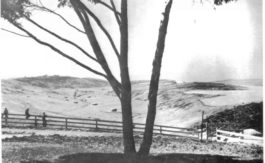The History of The Gated City – Rolling Hills
In 1848, California was ceded to the United States. Soon after California was admitted to the Union, San Pedro became a Port of Entry due to the efforts of such prominent citizens as Abel Stearns and Phineas Banning. Three stagecoach lines carried passengers from the Port into the City of Los Angeles. The route the stagecoaches followed is roughly that of the Harbor Freeway, and it took under four hours to make the journey by stagecoach.
The Sepulveda family began to lose control of the Rancho in 1853 when the court awarded one-fifth of the property to the heirs of Santiago Johnson, who had traded San Bernardino holdings for the land. The bottom dropped out of the cattle market, and the Sepulveda’s had to mortgage their land. Legal fees to defend their title and a severe drought in 1864 drained their resources. From 1865 to 1880, there were 78 lawsuits filed to clear title to the land of Rancho de los Palos Verdes. The delinquent tax lists and records of mortgage foreclosures tell the story, the heirs of the Dons were losing their land. By 1882, Jothan Bixby was in possession of half the Rancho and using the Peninsula part of that land for grazing and agriculture. Bixby decided to sell the Peninsula portion of his holdings, and in 1913 these 16,000 acres were purchased by a syndicate of investors organized by Frank A. Vanderlip, Sr.
Elaborate plans were formulated for the area. There were to be three model villages, a polo field, golf links, and tennis courts. Before they could become realities, the United States went to war. An observation station was set up near the end of Flying Mane Road. The late Roland Swaffield, in his book on Rolling Hills, tells about inspecting the station when he was serving as an Artillery Captain in World War I.
By the time the war was over, the investors had lost interest in the project. E.G. Lewis and the Commonwealth Organization that he headed took an option on the land, but the project faltered. Frank Vanderlip helped salvage the project and a Real Estate trust was formed to launch the sale of lots in Palos Verdes Estates and Miraleste. The campaign succeeded. Homes were constructed, among them the Farmstead, the Villetta and Villa Francesca. La Venta Inn was built and figured prominently in the sales of promotion. In 1925 a business building was completed in the Plaza, but after that the depression hit the Peninsula. Real Estate wasn’t selling. The Rolling Hills area was being used for farming at this time. The first house to be built within the boundaries of the city was constructed in 1894 near the present city hall. It was the home of Harry Phillips, ranch manager of the Bixby Peninsula land holdings. The site of another early ranch house was on what is now the Shultz property in Johns Canyon. Cattle ranged the hillsides and fields of barley were harvested. Tenant farmers raised their crops. As the depression gripped the nation, WPA work crews built roads. Palos Verdes Drive north was constructed at this time by hand labor working with pick, shovel, and wheelbarrow.
Excerpt from, “A Guide to the Rural City of Rolling Hills”








